Favorite Foods That Prevent Heart Disease
And Help Clear Blocked Arteries
Without Pharmaceuticals Or Surgery
by Dina Eliash Robinson
-
- INTRODUCTION—The Good News
- Docs Getting On The Nutrition Bandwagon
- International Focus
- Economic Advantages and Gastronomic Pleasures
- Choosing The Most Powerful Nutrients For Effective Cardiac Damage Control
- The Optimum Food Plan For Cardiovascular Health
- Commitment
- Go For Good And Plenty
- Food, Glorious Food
- Fruits & Veggies
- Herbs & Spices
- Nuts & Seeds
- Whole Grains—ORGANIC (to avoid toxic chenicals, GMO & GE products)
- Oils & Fats
- Dairy
- Meats
- Fish & Seafood
INTRODUCTION—The GOOD News: More than two decades of research, personal observation and experience in our own family, have provided strong evidence that cardiovascular disease can be prevented, as well as reversed with heart-healthy eating habits, moderate exercise, stress-reduction and food-based supplements,
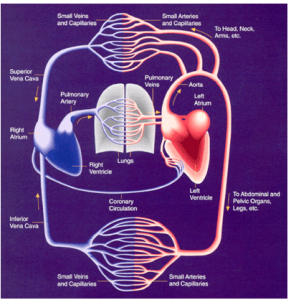 without pharmaceuticals or invasive procedures. Note: Vitamins amd other food- based supplements should only be taken on the advice of professional health practitioners—such as nutritionists, holistic therapists, and the growing number of cardiologists and other physicians who are finding them useful.
without pharmaceuticals or invasive procedures. Note: Vitamins amd other food- based supplements should only be taken on the advice of professional health practitioners—such as nutritionists, holistic therapists, and the growing number of cardiologists and other physicians who are finding them useful.
In fact, prevention and reversal of cardiovascular disease through foods and lifestyle changes are proving successful even for people with inherited ‘bad’ genes that have caused heart attacks, strokes and/or premature deaths to a parent, sibling or other closely related family member. Reports about the effectiveness of foods as therapeutic agents in the reversal of illnesses—even in cases when genetic predisposition is combined with previous years of self-destructive eating habits—are appearing with increasing frequency in both scientific medical journals and mainstream media.
Docs Getting On The Nutrition Bandwagon: More and more physicians are poaching on nutritionists’ territory by accompanying prescriptions with advice on healthy eating and lifestyle changes. Celebrity doctors are writing cookbooks, pontificate about trendy diets on their own TV and radio shows, write syndicated columns, appear on magazine covers and have bylined articles published in newspapers.
Dr. J. Kellogg Parsons, urologic oncologist at the UC San Diego Moores Cancer Center revealed in a September 2011 interview with the SD Union-Tribune that extensive epidemiological studies conducted by the Center have shown evidence that a heart-healthy diet, “when applied to the prostate cancer patient… has the same great results” (as in cardiac patients). Dr. Parsons recommends a “diet high in vegetables, low in fat (and) meat. Vegetables are particularly important.” (FRC Caveat: Starchy veggies, such as potatoes, should be consumed less frequently and in smaller portions to avoid weight gain.)
International Focus: In addition to the domestic trend, there is considerable pushback by various countries around the world against the U.S.-promoted over-reliance on medicines, agricultural chemicals, fast food chains and factory farm products—as well as a shift toward linking organic foods with health. This is reflected in various comments and articles being receiving at FreeRangeClub from abroad.
Here is an excerpt focused on cardiovascular disease contributed by Dr. Millie M. Bruce, a native of Banffshire, Scotland and graduate of the University of Glasgow with a degree in traditional medicine and nutrition. She writes: “Cardiovascular disease is rapidly approaching gender-equal status now that women are shouldering careers in addition to their parenting and homemaking responsibilities.” Citing her research and special interest in this field, Dr. Bruce warns that “Increasingly, the danger zone is not age but physical condition, eating habits, lifestyle and even emotional or mental state, which affects how individuals deal with stress.”
Economic Advantages And Gastronomic Pleasures: Commonsense and household budgets show that wholesome foods are not only healthy, but more enjoyable, satisfying and economical–saving money that otherwise would have to be spent on medical treatments, pharmaceuticals, missed work and at extreme, on hired caregivers. With a plethora of accessible information available in books, classes and on the Internet, even the most kitchen-averse consumer can easily learn a few life-improving grocery shopping and quick and easy cooking skills.
Choosing The Most Powerful Nutrients For Effective Cardiac Damage Control: To fully reap the health benefits of good eating habits—while also pleasing taste buds, of cou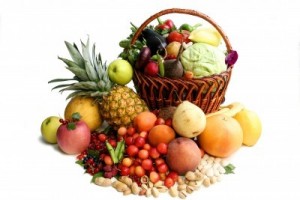 rse—we recommend that you:
rse—we recommend that you:
(1) Choose all organic and, whenever possible, locally grown foods, because the shorter the distance between farm and table, the less energy is consumed and smaller carbon footprint is left by transportation (a clean air bonus for heart-health) and, above all, the fresher and higher in nutritional value are the foods you eat. Being a ‘locavore’ also has the added benefit of eating fruits and vegetables in season, at the top of their healing power.
(2) When locally grown organic produce is not available, look for equivalents grown in other parts of the U.S.—or when those, too, are missing from your grocer’s shelves, settle only for Canadian or Mexican choices sporting the USDA organic stamp. Although organic imports from Chile are of good quality, their nutrient levels are lowered by pre-ripened harvesting and long haul transportation. And since Chile’s winter is our summer and vice versa, the health bonus of in-season consumption of plant foods is also lost.
(3) Pay special attention to points of origin information on packages when shopping for frozen fruits and veggies and limit your picks to U.S. and Canadian goods. Avoid even organic imports from China because of that country’s continuing struggles with polluted soil, air and water—against which its own citizens frequently protest.
(4) Whenever you are tempted to save a few pennies by reaching for less expensive produce, remind yourself that organic foods pay remarkable health dividends by allowing the body to use their entire energy and self-healing resources for prevention, damage control and health maintenance. By contrast, when consuming conventionally grown or processed foods, the body must first engage its immune system in the battle to protect itself from the toxic chemicals (pesticides, fungicides, chemical fertilizers, antibiotics, growth hormones, etc.) and genetically engineered products embedded in these foods. Not only does this battle deplete the body’s self-healing resources, but toxic chemicals and genetic tampering also tend to diminish the nutritional value of conventionally produced foods.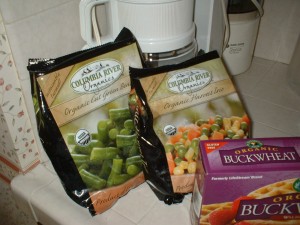
The Optimum Food Plan For Cardiovascular Health:
(a) Eat a hearty breakfast every morning, starting with a tall glass of water (room temperature) with a splash of some organic fruit juice if you prefer flavoring. Follow with a slice of melon or other fruit. The ‘main course’ might consist of a slice of whole grain (wheat, spelt, kamut, etc.) waffle with fruit; slice of toasted bread with avocado, almond or walnut butter or other low-cholesterol topping; an egg-white and veggies or mushroom omelet with olive oil; a small ‘variety’ plate with humus, sliced tomatoes and olives with whole grain crackers; etc. Green tea for a concluding pick-me-up is better than coffee, although one or two cups of low- or moderately caffeinated Java have lately been given the green light for heart-healthy diets. For a richer flavor, try a cup of weaker coffee with a ½ teaspoon of unsweetened organic cocoa and splash of almond milk.
(b) While it’s best to eat the larger meal at midday, it is advisable to keep portions served at both lunch and dinner as small as possible, so as not to overtax the digestive and cardiac systems. The ideal (balanced) meal consists of…
• a big salad of dark leafy greens, tomato, radish, pepper, onion (optional when in company), followed by a protein and grain; or
• steamed or sautéed vegetables (non-starchy) occupying about half the plate, with the rest of space split between
• a fist-size portion of lean, low-cholesterol protein—such as salmon or other Omega-3-rich oily, medium or small size fish; white/breast meat of organic chicken or turkey; tofu or tempeh; the vegetarian whole protein combo of rice and beans, etc. (it is strongly suggested that red meat be avoided altogether); and
• a cup of whole grain pasta, rice (except in the presence of the above rice and beans) or other starch.
(c) If (b) is lunch, dinner could include a hot or cold soup and a Mediterranean platter of hummus, salad, olives and sardines; or whole grain pizza crust with vegetable and goat cheese topping. Or, as indicated above, these lunch and dinner suggestions are interchangeable.
(d) The important thing is to keep portions small and food items light and easy to digest to avoid bloating or feeling ‘stuffed.
(e) When main meals are reasonably light, with moderate portions, it is better to have snacks between meals, than to let hunger build to over-indulgence during the next meal. Snacks could include a fruit with organic, low-fat yogurt; about 10-12 almonds or other nuts with a handful of raisins; a slice of whole grain bread with almond butter or some other low-calorie and low-cholesterol choices.
(f) Four-hour intervals between main meals help prevent overeating, while finishing dinner at least two hours between bedtime benefits digestion, avoids putting pressure on the heart and allows for a good night’s sleep.
(g) Regular exercise, stress management, home cooking and/or judicious selection of dishes and ingredients when eating out, also helps to maximize the
effectiveness of healing foods.
Commitment: To quote Yoda, “Do or do not. There is no try.” In short, staying the course helps to fast-track the cardiovascular healing process and lifestyle changes, as well as to prevent relapses. While temptations abound—often in the form of lovingly prepared but artery-clogging foods offered by well-meaning friends and family—they can be resisted by remembering to differentiate between myths and facts:
• Myth: Indulging only rarely in artery-clogging or inherently toxic foods won’t harm.
•Fact: Every morsel of adulterated and/or artery-clogging food is sure to set back the healing process or negatively affect prevention efforts.
• Myth: It’s OK to skip regular exercise or relaxation practices—two days a week is plenty.
• Fact: Inactivity lets arteries collect plaque and neglecting to keep stress hormones in check has the potential to impede or reverse recovery. The goal should be to exercise and de-stress at least five days a week. (Don’t groan. Throw your arms up, grin broadly to the ceiling and shout a gleeful ‘Yeah!’ to get you psyched about the healing process. Attitude is everything.)
• Myth: Backsliding can easily be made up for later.
• Fact: Lifestyles are habits that can be as addictive as alcohol and drugs. Falling off the wagon has serious consequences—especially for those with a genetic tendency (family history) of cardiovascular problems. The sooner bad habits (i.e. addictions) are broken and healthy ones put in their place, the faster the struggle ends and re-habituation is etched into the subconscious.
• Myth: Once cardio-health is restored, it’s safe to go back to less than optimum lifestyle.
• Fact: This is the most dangerous fantasy. Resuming old habits that caused the heart disease originally tends to precipitate a relapse that occurs faster and tends to be more severe than the first onset.
• Good News: It takes about two to four months for taste buds to develop a preference for heart-healthy flavors and for a new lifestyle to become routine. The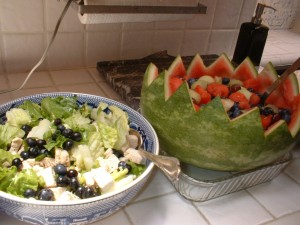 successful transition can be hastened and helped by making sure that meals are not only nutritionally well balanced, lovingly prepared with organically grown, low-cholesterol ingredients, but delicious as well—a goal achieved through skillful seasoning with healthy and antioxidant-rich herbs and spices. (Click on our ‘Recipes’ section and try them as written, or improvise to include your favorite flavors—while still making sure, of course, that all changes and substitutions are heart-healthy.)
successful transition can be hastened and helped by making sure that meals are not only nutritionally well balanced, lovingly prepared with organically grown, low-cholesterol ingredients, but delicious as well—a goal achieved through skillful seasoning with healthy and antioxidant-rich herbs and spices. (Click on our ‘Recipes’ section and try them as written, or improvise to include your favorite flavors—while still making sure, of course, that all changes and substitutions are heart-healthy.)
Caveat: If and when eating out—in restaurants or private homes–I recommend making your wait staff or host(ess) an ally who’ll be glad to answer your (polite) questions about ingredients and cooking modes (anything but fried or barbequed!) of the meals being served. Good manners require that you at least taste what is offered, or quietly point to, or serve yourself the dishes that best suit your Food Plan.
Go For Good And Plenty: Far from being ‘restricted,’ The Optimum Food Plan For Cardiovascular Health includes a veritable cornucopia of delicacies in mouthwatering flavors, textures and a variety of preparation choices. The ones that are really ‘restricted’ are, in fact, the fast- and junk foods, since their main (health-busting) ingredients are fat, salt, sugar, pesticides-laden plants, refined and genetically engineered (GMO) grains and processed animal products spiked with growth hormones and antibiotics.
Food, Glorious Food! While a completely plant-based diet is not everyone’s preference, increasing fruits and vegetables is good for the heart. The healthiest vegetables and fruits are those with the strongest, darkest colors. Often called ‘super-foods,’ they are rich in vitamins, minerals and other nutrients, as well as in antioxidants that protect the body from cancer-causing free radicals. Their high fiber content also aids digestion and lowers blood pressure— essential attributes for cardio safety. Here is an incomplete list of goodies known for their powerful cardiovascular healing properties. Write to us for more information—or to add your own—at [email protected].
FRUITS & VEGGIES
• Dark leafy vegetables (collard greens, kale, chard, spinach).
• Cruciferous vegetables (broccoli, cauliflower, cabbage, Brussels sprouts).
•Root vegetables (carrots, parsnips, yams, sweet-potatoes, radishes, rutabaga, turnips, beets—the latter is also an excellent liver-cleanser).
•Nightshades (eggplants, peppers, tomatoes, cucumbers, potatoes—to be consumed in moderation, since they tend to worsen arthritis symptoms when eaten too often or in large quantities).
•Squashes (acorn, spaghetti, crookneck, zucchini, pumpkin, etc.).
•Antibacterial/anti-viral vegetables (onions, leeks, scallions, garlic—the latter is a particularly powerful antidote for inflammations, infections and flu and cold viruses, as well as being an effective blood-thinner that—when taken as prescribed in concentrated doses found in supplements such as ‘Kyolic’ garlic capsules—helps prevent clots that could cause phlebitis or strokes).
•Legumes (beans of all kinds, lentils, peas, chickpeas—the latter is excellent when prepared as hummus with tahini, lemon and garlic).
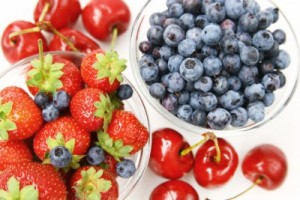 •Berries (blueberries, blackberries, strawberries, raspberries—often called ‘super-foods’).
•Berries (blueberries, blackberries, strawberries, raspberries—often called ‘super-foods’).
•Açai, a fairly recently introduced and much hyped food growing on trees along the Amazon river, has been mistakenly called a berry—it is actually a drupe, a pitted fruit just like the olive. Açai has no sugar, but is twice as rich in anthocyamins as dark blue and red berries and red wine; and has high contents of antioxidants, Omega-6 and -9, fiber and polyphenols. (Not recommended for diverticulitis sufferers, because of its abrasive nature.)
• Melons (honeydew, cantaloupe, watermelon, Galia, Crenshaw, etc.).
• Stone fruits (peaches, nectarines, plums, apricots, cherries).
• Avocados are rich in minerals, vitamins and heart-healthy fat—making it somewhat high-caloric, but still one of the most nourishing super-foods. Among its various species, the Haas—also known as ‘alligator pear’ because of its rough skin—is dense and fatty, with a nutty flavor, while the Reed and Bacon are larger, smooth-skinned, have a lighter, less fatty flesh and a fresh, ‘green’ flavor. The latter are often less expensive than the Haas.
• Citrus (oranges, mandarins, lemons, limes—grapefruit is best avoided because it may interact with medications and/or supplements or have adverse effects on certain conditions).
•Apples and pears come in many variations of colors, textures and flavors and are as delicious in their fresh and raw state as baked, poached, puréed (i.e. apple sauce) and stewed in compote.
• Tropicals (persimmons, pomegranates, bananas, mangoes, papayas, etc. Pomegranates are rich in iron, bananas in potassium and papayas are excellent digestive aids).
HERBS and SPICES for a healthy heart
Herbs and Spices are largely responsible for the pleasures of eating, since they add to, as well as bring out the flavors of individual foods. (Think, for example, sliced yam coated with olive oil, basil, turmeric, paprika and garlic powder and baked until almost crisp.) In addition to making salt unnecessary—a good thing for salt-restricted cardio diets—herbs and spices also pack many powerful medicinal qualities. Here are some of the most popular:
• Basil and Dill, like most herbs, contain multiple medicinal compounds, each an effective healing agent for one or more ailments. Among them is eugenol, an antioxidant that also protects against heart disease and thrombotic stroke by inhibiting the clumping of platelets into dangerous clots.
dangerous clots.
• Fennel—a plant relative of dill, coriander, parsley and carrots—is completely edible: its crunchy white bulb, fibrous stalks, seeds and thin dill-like leaves (ideal in fish dishes). It is also a health-supportive powerhouse, rich in antioxidants such as vitamin C and cholesterol-reducing fiber that protects the cardiovascular system and the colon (from which it removes potentially carcinogenic toxins). The fragrant fennel is also a good source of folate (a B vitamin that protects blood vessel walls from damage) and potassium. Among other health benefits, folate and the blood-pressure-lowering potassium help prevent heart attacks and strokes.
•Ginger also possesses similar anti-platelet-clotting qualities, with added elements that prevent cardiovascular disease by balancing lipids, inhibiting fat absorption from the intestines and thus lowering the ‘bad’ (LDL) cholesterol and triglyceride levels, while raising the ‘good’ (HDL) cholesterol.
•Parsley inhibits the formation of plaques in arteries and also acts as a blood-thinner—both important factors in the prevention of heart disease and stroke.
•Oregano and Rosemary have cardio-protective, antioxidant and anti-inflammatory carvacrol and rosmarinic acid, which prevent plaque formation in arteries.
•As reported in 2010 by Nutrition Journal, in an analysis of more than 3100 foods around the world, Tarragon has been found to pack one of the highest antioxidant contents among them. Due to its abundance of the anti-inflammatory salicylic acid and several key phytochemicals, fresh tarragon especially, is a powerful shield against cardiovascular disease.
•The same analysis reports identical findings for Thyme due to several cardio-protective phytonutrients.
•Perhaps the most often prescribed medicinal plant for the prevention (and healing) of heart disease is Turmeric, a root sold in powder form, which lends its strong yellow color to Indian curry and the phytonutrient curcumin to its healing power. Turmeric’s antioxidant qualities make it highly effective as a protector and therapeutic weapon against HIV, cancer and arthritis.
•Cayenne and other hot chili peppers rich in capsaicin reduce blood cholesterol, lower triglyceride levels and increase the body’s ability to dissolve fibrin, a substance that promotes clot-formation. Where cayenne is one of the popular spices good for heart health, there are much lower rates of heart attacks, stroke and cases of pulmonary embolism.
NUTS & SEEDS
•Almonds, walnuts, cashews, Brazil nuts, macadamia nuts, pecans, sunflower and sesame seeds, among others, are rich in Omega-3 fatty acids, proteins and other heart-healthy nutrients. (I advise staying away from peanuts if possible, for reasons explained at http://freerangeclub.com/category/food-safety/page/3/).
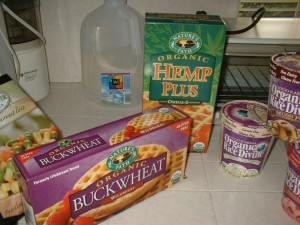 WHOLE GRAINS—ORGANIC (to avoid toxic chemicals, GMO & GE products)
WHOLE GRAINS—ORGANIC (to avoid toxic chemicals, GMO & GE products)
•Hot oatmeal (whole oats) cereal is highly effective in lowering blood pressure and clearing arteries.
• Whole grain (wheat, spelt, kamut, the complete-protein-containing quinoa, etc.) cereals, pasta, pilaf, breads and rice (wild, brown, basmati, jasmine, etc.) are important energy fuels, rich in nutrients. Still, it’s good to keep in mind that they are carbohydrates with high (complex) sugar and starch content that have the potential to become addictive ‘comfort’ foods and pack on unwanted weight—always a detriment to cardiovascular health. It’s best, therefore, to keep portions small to medium and to eat grain-based foods not too frequently.
OILS & FATS
•Heart-healthy fats are limited to polyunsaturated and monounsaturated oils.
•Polyunsaturated fats include plant-based oils (of which safflower and sunflower oils are preferable.
• Corn and soy oils are also ‘poly,’ but should be avoided or used with caution—the former to avoid allergic reactions in people sensitive to corn and the latter because its high concentration of the plant estrogen present in soybeans can be harmful to breast cancer sufferers and survivors. Absent allergies or estrogen-uptake cancer hazard, corn and soy oils contain heart-healthy Omega-3 fatty acids—also found in ground flaxseed and walnut oils.
•Monounsaturated fats include the super-heart-healthy olive oil (choose organic, extra-virgin, cold- and first-pressed products from reputable California, Italian or other trusted sources), as well as avocados (fruit and oil), nuts and seeds (including butters and oils derived from them).
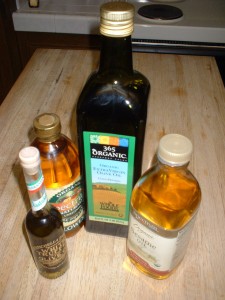 Note: Olive oil is at its best when drizzled on salads at room temperature. It is also a tasty, heart-healthy fat in low-heat cooking—which is, in fact, advisable for protecting the cardiovascular system. Foods cooked at high heat (i.e. fried, barbecued and blackened in any form) are hazardous to most people’s health due to their artery-clogging and carcinogenic effects. Boiling, simmering, poaching, sautéing, baking and roasting at below 400 degrees are the optimum cooking methods all around and especially important for keeping the old pump and its vascular plumbing in the pink.
Note: Olive oil is at its best when drizzled on salads at room temperature. It is also a tasty, heart-healthy fat in low-heat cooking—which is, in fact, advisable for protecting the cardiovascular system. Foods cooked at high heat (i.e. fried, barbecued and blackened in any form) are hazardous to most people’s health due to their artery-clogging and carcinogenic effects. Boiling, simmering, poaching, sautéing, baking and roasting at below 400 degrees are the optimum cooking methods all around and especially important for keeping the old pump and its vascular plumbing in the pink.
DAIRY
•For prevention of cardiovascular problems, a good rule of thumb is to limit dairy intake to small portions of goat yogurt, kefir, Feta cheese or organic chevrie-style low-fat creamy white cheese, once or twice a week. Goat dairy is, in general, lower in fat, has healthy enzymes that make it easier to digest than cow products and is a good source of calcium. By all means, however, all hard, yellow and fatty cheeses (such as Brie) in both goat and cow dairy should be completely avoided.
•For those on limited dairy food plans, on the rare occasions when cow dairy is the only option, it should at least be organic in order to avoid dairy laced with the antibiotics, growth hormones and pesticide-laden and/or otherwise toxic feed that cows are injected with or eat. But even organic cow dairy should be limited to low- or non-fat yogurt, kefir or cottage cheese, while avoiding aged, hard, Brie and other cheeses with higher fat and cholesterol content.
•To reverse cardiovascular disease, on the other hand, it is best to avoid all dairy. There is, however, the option to substitute non-dairy soy or rice cheeses and other plant-based imitations, which are surprisingly tasty and satisfying.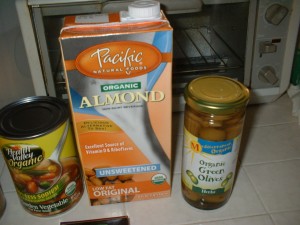
•Health status and lifestyle should be reviewed periodically with a nutritionist, holistic health practitioner or in acute cases, with a cardiologist. Examination results and the person’s overall condition at the time will determine what, if anything, needs to be tweaked in his/her food choices aimed at preventing, maintaining or reversing the cardiovascular condition.
MEATS
•Whether the purpose is prevention or reversal of cardiovascular problems, it is best to completely avoid red meat—especially for people with a family history of the disease.
• Young, healthy people with no genetic connection to it, might indulge in small portions of grass-fed or organic New Zealand lamb (fat trimmed), on rare occasions. (Click here for reasons to avoid domestic factory-farm-grown beef: http://freerangeclub.com/food-safety/slaughterhouse-blues/.)
•As with dairy, healthy people who wish to prevent cardiovascular problems have a bit more leeway than those who need to reverse the condition. While both can have organic, skinless, fat-trimmed chicken and turkey in small portions, two-three times a week, ‘preventers’ could have some dark meat now and then, while it’s best for the ‘reversers’ to stick to white breast meat. (See our “Healthy Recipes” for cooking ideas.)
FISH & SEAFOOD
• Cold-water fish such as salmon, mackerel and herring are good sources of Omega-3 fatty acids and known to be heart-healthy.
• Choose small to medium size fish to limit your mercury intake. Wild-caught sardines (fresh or canned in pure olive oil) and wild-caught herring (fresh and preserved in wine or other liquid, but not cream) are perhaps the overall healthiest (and affordable) sources of protein on the market. The bigger the fish, the more mercury is accumulated in its flesh.
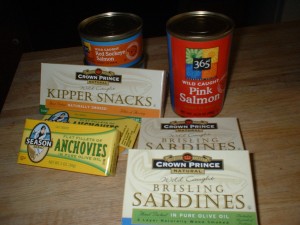 • Wild-caught, deep-sea scallops and calamari are the only recommended non-fish seafood—especially for cardiovascular health—since coastal waters tend to be polluted around the world, shrimp is too high in cholesterol and other shellfish are too frequently found to be contaminated with various toxic organisms to be given a blanket approval.
• Wild-caught, deep-sea scallops and calamari are the only recommended non-fish seafood—especially for cardiovascular health—since coastal waters tend to be polluted around the world, shrimp is too high in cholesterol and other shellfish are too frequently found to be contaminated with various toxic organisms to be given a blanket approval.
•While consuming wild-caught fish and seafood is becoming less and less sustainable due to global overfishing, the marine farming industry—with perhaps some exceptions—doesn’t seem to have quite figured out yet how to be entirely eco-friendly, nor how to raise seafood that is both as nutritious as its wild-caught counterparts and free of antibiotics, anti-fungals and other toxic substances.
A reasonable and relatively safe compromise might be to eat wild-caught fish and other seafood (as listed above) freely, whenever affordable and available, while eating less of the farmed products—which are usually served in restaurants and other public or hosted places.
•Note: Don’t be fooled by fish and seafood identified as “Wild,” which only means that the marine farm is stocked with previously free-swimming fish or their progeny. The two-word “Wild Caught” is the only label that identifies the real thing. We recommend it for optimum healing and health maintenance.
IMPORTANT: A SUPPORTIVE ENVIRONMENT FOR HEART-HEALTHY LIFESTYLE
To help a family member through the first 4-6 months of struggle to transition from an old and less than ideal eating habit to a heart-healthy food plan, it would be most helpful—at least when cooking and eating at home—to prepare and serve the same cardio-wise, nutritious dishes for everyone. This not only prevents the re-habituating person’s frustration or backsliding by cheating with ‘forbidden’ foods, but it also provides an extra health bonus for family and friends who share the same meals. This, of course, also makes grocery shopping simpler and more economical—not to mention saving time and effort in cooking and washing up.
Most people are surprised by how quickly their taste buds become accustomed to the new flavors and how put off they become even by the smells and appearance of their once-favorite (unhealthy) foods. It is also helpful that these days most restaurants are more than willing to substitute healthier ingredients—such as olive oil for butter—or adjust recipes to accommodate diners’ needs. Even friends and relatives are learning to ask people they invite for home-cooked meals for their preferences.
CHALLENGE US to adapt your recipes to your and your family’s (and/or friends’) health needs. If you wish, we’ll post the “Before & After” versions of your contribution(s) on this site. E-mail your recipe(s) to [email protected]

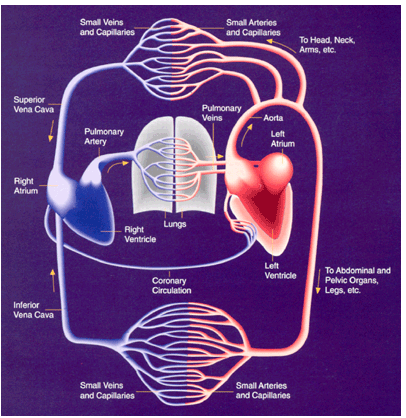

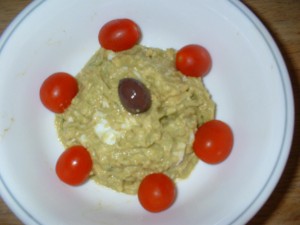
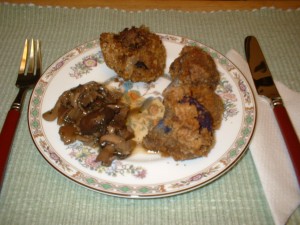
7 Comments on “Eat Your Way To Cardiovascular Fitness”
I am a huge fan of Free Range Club and I love all of your work! You are amazing; I’d love to contribute in anyway possible if you are ever in need of clean, healthy recipes!
Have a great day.
Thank you!
Best,
Amie Valpone
Culinary Marketing Consultant
The Healthy Apple
http://www.TheHealthyApple.com
I had formed my spleen taken out and my platelets continue to be low now my white blood cells are generally high.
can there be any medication I could take with
this.
Dear Nikole, So sorry about your health problems. Wish we could help, but can’t, since this is NOT a medical site. Our expertise is limited to foods and nutrition. Please consult your physician and do take good care of yourself. We wish you good health.
Editors, FreeRangeClub.com
Message from Penelope Andrade, emailed April 3, 2015
Hi Dina,
I just checked your website…love what you are doing to get people into healthy eating. As a psychotherapist, one of the first questions I ask clients is about diet. it’s so important. As a matter of fact if people ate right, exercised daily, and did a little of my Emotional Medicine Rx: Cry When You’re Sad, Stop When You’re Done, Feel Good Fast (That’s the title of my soon to be launched on Amazon book!) they wouldn’t need me at all.
…..we are sisters in our concern and devotion to making life better for our human family.
warm regards,
Penelope Andrade —
Excellent article, as always Dina! We follow your guidelines on a daily basis. My dear mother always told me, “You are what you eat,” and goodness knows, she was correct! Here’s to organic everything. Happy Mother’s Day to you!
Pingback: Brain Foods For Healthy Mind, Memory And Clear Thinking - FreeRangeClub
Start eating old-fashioned oatmeal—or, even better, steel-cut oats—for breakfast. Oatmeal is high in soluble fiber that helps remove harmful LDL cholesterol from the body. Top your oatmeal with bananas, fresh or frozen blueberries, raisins, walnuts, or pecans. To save time, make a large batch of oatmeal, refrigerate it, and reheat individual portions throughout the week.